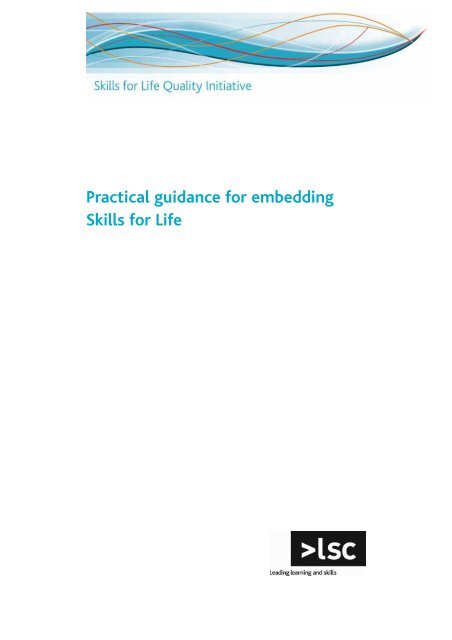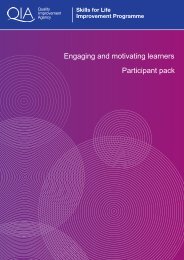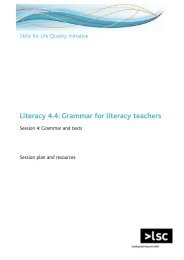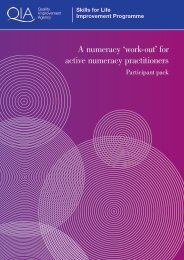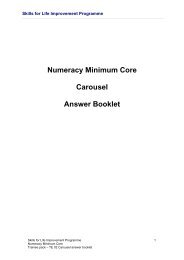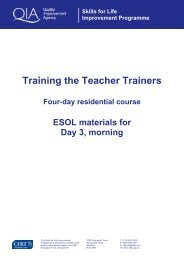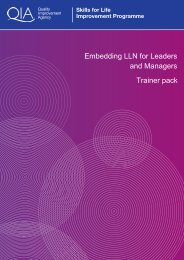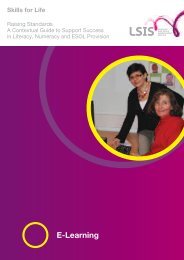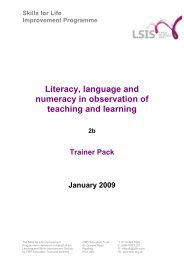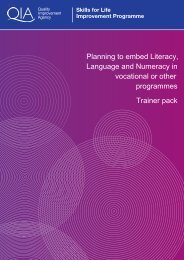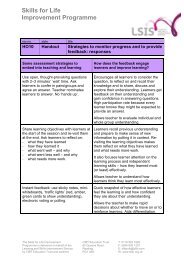Practical guidance for embedding Skills for Life - Excellence Gateway
Practical guidance for embedding Skills for Life - Excellence Gateway
Practical guidance for embedding Skills for Life - Excellence Gateway
Create successful ePaper yourself
Turn your PDF publications into a flip-book with our unique Google optimized e-Paper software.
<strong>Practical</strong> <strong>guidance</strong> <strong>for</strong> <strong>embedding</strong><strong>Skills</strong> <strong>for</strong> <strong>Life</strong>
© Crown copyright 2006Learning and <strong>Skills</strong> Council <strong>Skills</strong> <strong>for</strong> <strong>Life</strong> Quality Initiative 2005-06
<strong>Practical</strong> <strong>guidance</strong> <strong>for</strong> <strong>embedding</strong> <strong>Skills</strong> <strong>for</strong> <strong>Life</strong> 1Contents1. What is embedded <strong>Skills</strong> <strong>for</strong> <strong>Life</strong>? 12. Models and approaches 23. Approaches to staffing embedded <strong>Skills</strong> <strong>for</strong> <strong>Life</strong> learning 44. Funding 75. Embedding LLN and the Common Inspection Framework 86. What are the lessons learned from national projects? 107. Key resources 148. Useful contacts/websites and links to national research 16
<strong>Practical</strong> <strong>guidance</strong> <strong>for</strong> <strong>embedding</strong> <strong>Skills</strong> <strong>for</strong> <strong>Life</strong> 1The Learning and <strong>Skills</strong> Council (LSC) <strong>Skills</strong> <strong>for</strong> <strong>Life</strong> Quality Initiative (SFL QI) is anessential aspect of the Government’s commitment to improving the literacy, languageand numeracy skills of adults. This practical <strong>guidance</strong> document <strong>for</strong>ms part of a setproduced by the LSC <strong>Skills</strong> <strong>for</strong> <strong>Life</strong> Quality Initiative in 2005–06. Each document focuseson one of the national priorities of the LSC <strong>Skills</strong> <strong>for</strong> <strong>Life</strong> Quality Initiative in 2005–06:1 supporting the development of whole organisation approaches;2 <strong>embedding</strong> <strong>Skills</strong> <strong>for</strong> <strong>Life</strong>;3 training in <strong>Skills</strong> <strong>for</strong> <strong>Life</strong> leadership and management;4 extending the facilitator network to include coaching and mentoring;5 promoting the e-learning agenda;6 supporting the interface between key skills and <strong>Skills</strong> <strong>for</strong> <strong>Life</strong>;7 developing a continuous professional development framework and in<strong>for</strong>mation,advice and <strong>guidance</strong>;8 disseminating good practice.The key agencies involved in the <strong>Skills</strong> <strong>for</strong> <strong>Life</strong> Quality Initiative are:> CfBT> LLU+(London South Bank University)> National Institute of Adult Continuing Education (NIACE)> Learning and <strong>Skills</strong> Development Agency> Cambridge Training and Development Ltd> University of Wolverhampton> National Research and Development Centre <strong>for</strong> Adult Literacy and Numeracy.Further in<strong>for</strong>mation on the <strong>Skills</strong> <strong>for</strong> <strong>Life</strong> Quality Initiative can be found on its websitehttp://www.sflqi.org.uk, where you can also register to receive regular updates throughan eBulletin.This practical <strong>guidance</strong> on <strong>embedding</strong> literacy, language and numeracy into vocationaland other programmes aims to in<strong>for</strong>m and support teachers, tutors and trainers involvedin working with learners on vocational programmes who need to improve their literacy,language and numeracy skills.
vi <strong>Skills</strong> <strong>for</strong> <strong>Life</strong> Quality InitiativeThis <strong>guidance</strong> covers:> What is embedded <strong>Skills</strong> <strong>for</strong> <strong>Life</strong>?> Models and approaches> Approaches to staffing embedded learning> Funding> Embedding LLN and the Common Inspection Framework> What are the lessons learned from national projects?> Key resources> Useful contacts/websites and links to national researchResearch suggests that people learn best when it is meaningful and they can see howlearning a new skill or developing their knowledge or understanding will enhance theirlives. 11 NRDC Research Report: Embedding teaching and learning of adult literacy, numeracy and ESOL,August 2005
<strong>Practical</strong> <strong>guidance</strong> <strong>for</strong> <strong>embedding</strong> <strong>Skills</strong> <strong>for</strong> <strong>Life</strong> 11. What is embedded <strong>Skills</strong> <strong>for</strong> <strong>Life</strong>?The DfES <strong>Skills</strong> <strong>for</strong> <strong>Life</strong> Strategy Unit defines embedded teaching and learning as follows:Embedded teaching and learning combines the development of literacy, language (ESOL),and numeracy with vocational and other skills. The skills acquired provide learners withthe confidence, competence and motivation necessary <strong>for</strong> them to succeed inqualifications, in life and at work.It’s supportive; if you’re on a vocational programme, it helps you to achieve your goal 2A learner’s vocational success can easily be affected by poor development of LLN skills.The primary motivation <strong>for</strong> many learners is in their vocational or other interests ratherthan in specific development of their literacy or numeracy skills. Embedding LLN withinvocational and other programmes enables learners to develop both sets of skills in anintegrated and meaningful way.2 Developing embedded literacy, language and numeracy: supporting achievement Jan Eldred,NIACE, 2003.
2 <strong>Skills</strong> <strong>for</strong> <strong>Life</strong> Quality Initiative2. Models and approachesThere are different approaches to <strong>embedding</strong> literacy, language and numeracy into otherareas of training or study. Organisations should avoid a ‘one size fits all’ policy: rather,they should adopt an approach that fits the subject, the environment or context, thelearner and the resources available. Embedding has an impact on the whole strategy <strong>for</strong>delivering a course including recruitment, assessment, staffing and learning materials.Some organisations found that selecting one curriculum/occupational area <strong>for</strong> intensivefocus of ef<strong>for</strong>t enabled them to progress more rapidly to the development of an effectivemodel <strong>for</strong> <strong>embedding</strong> <strong>Skills</strong> <strong>for</strong> <strong>Life</strong>. 3Different models of embedded delivery> Dual skills teaching – one teacher.> Integrated team teaching – a team of teachers with complementary expertiseworking together, with the possible inclusion of an element of team teaching.> Linked or contextualised teaching – LLN linked to the vocational area usingcontextualised materials.> Other <strong>for</strong>ms of active collaboration between teachers to support learners’progress towards vocational and LLN goals. 4It is likely that literacy, numeracy and ESOL teaching expertise will be found in differentindividual teachers and this will influence the way they work together. The use of ‘LLN’ asa single abbreviated category within this document should be understood within thiscontext.Important features of all embedded models> Learners’ purposes, motivations and reasons <strong>for</strong> re-engaging into ‘host’ subjectsshould be paramount.> All models should be designed to deliver both ‘host’ subject and LLN, withlearning outcomes identified in both areas. These should be communicated tothe learner at the first point of contact and their benefits made clear.> The model of delivery will be influenced by the host subject, organisationalstructures, staff skills and experience.> Each area can influence the other.> Two areas of expertise must be acknowledged; these can be delivered by oneperson or, more often, through a team approach.> There is explicit teaching of appropriate LLN skills.Stages in the cycle of planning embedded work> Ensure teaching team has expertise in all relevant areas, e.g. vocational subject,literacy/communication, numeracy/AON, ESOL as required <strong>for</strong> the learner group.3 Whole organisation approaches <strong>for</strong> delivering <strong>Skills</strong> <strong>for</strong> <strong>Life</strong>, Pathfinder Project,http://www.woasfl.org/4 NRDC
<strong>Practical</strong> <strong>guidance</strong> <strong>for</strong> <strong>embedding</strong> <strong>Skills</strong> <strong>for</strong> <strong>Life</strong> 3> LLN teachers to research the way LLN are used in the particular vocationalcontext, e.g. the kinds of language used in training materials, or the languagestyles of teachers.> Identify LLN skills required by programme and map to vocational/LLN curricula.> Identify learner needs and match to course requirements, identifying priorities<strong>for</strong> teaching.> Plan sequence of LLN work to fit with vocational scheme of work.> Plan <strong>for</strong> elements of shared delivery.> Share plans and materials.> Agree processes <strong>for</strong> shared reviews of learner progress in both vocational andLLN development.> Schedule meetings <strong>for</strong> progress reviews and further planning. 5Suggestions <strong>for</strong> developing embedded provision> Both vocational and LLN teachers should consistently stress the purpose andvalue of <strong>embedding</strong> LLN and the benefits <strong>for</strong> learners.> LLN should be worked on where it arises naturally within the vocationalcontexts. Where other areas of LLN need to be learned, <strong>for</strong> example to achieveawarding body criteria, demonstrate generic employability skills as purposesrather than trying to make an artificial fit with the subject.> Many teachers, tutors or trainers may have fears or anxieties about embeddedwork. Vocational teachers may feel worried about their own skills in literacy andnumeracy; LLN teachers may feel out of their depth in an unfamiliar vocationalarea. Use staff development opportunities to share anxieties and reassure staffthat practical support is available, and that they need to work together tocombine their differing expertise.> Teachers from different departments need to develop confidence to worktogether and be motivated to work in this way. Staff training <strong>for</strong> all teachersneeds to be available to support <strong>embedding</strong>.> Support and develop team working through peer mentoring and coaching.> Foster mutual respect within and across teams and encourage teachers torecognise each other’s skills, knowledge and experience.> Learners should have individual assessment and feedback of their literacy andnumeracy development as well as subject learning outcomes.> The planning stage needs to identify the staffing model to be used and the levelof expertise required to successfully deliver each component. Staff roles need tobe clear and unambiguous and staff need time to plan together.> There needs to be an analysis of both the tasks and activities and the content ofthe subject so that the appropriate LLN components can be anticipated anddeveloped.> Schemes of work and session plans should have clear outcomes related to boththe subject specialism and the LLN aspects of the course. The whole learninginfrastructure must support an embedded approach.> Celebrate success in both areas of learning. Learners should have the opportunityto gain LLN qualifications.5 LSCSfLQI <strong>Practical</strong> Guidance on Whole Organisation Approaches
4 <strong>Skills</strong> <strong>for</strong> <strong>Life</strong> Quality Initiative3. Approaches to staffing embedded <strong>Skills</strong> <strong>for</strong> <strong>Life</strong>learningRaise awarenessThe first step in adopting a whole organisation approach to <strong>embedding</strong> <strong>Skills</strong> <strong>for</strong> <strong>Life</strong>should be raising awareness amongst all staff of learners’ <strong>Skills</strong> <strong>for</strong> <strong>Life</strong> needs and theissues around <strong>embedding</strong>.Ensure that there is engagement of staff in all parts of the organisation, and not just theobvious ones, <strong>for</strong> example, sole concentration on academic staff in colleges or assessors inwork based training. 6This could be through awareness training, presentations or workshops. For someproviders, the concept of screening and the notion of talking to learners sensitivelyabout literacy and numeracy levels may be a new way of working, and time shouldbe taken to adequately encourage, prepare and develop staff at all levels.Group training on awareness raising, and the requirement to look at training needs hashelped (organisations) to focus the essential training requirements, with a view toincorporating them into the staff development plan. 7It is worth noting that some staff may have LLN needs themselves and may there<strong>for</strong>e becautious or reluctant to support learners in this area.Enable staff to work and plan togetherEmbedding LLN is a developmental process involving staff, course teams, organisationsand, sometimes, external agencies. One successful embedded course can be used as aspringboard to develop further provision across the organisation as a whole. In this way,the staff involved could share their experiences with other colleagues. Consideration ofstaffing is critical to the successful and meaningful delivery of embedded programmesand is a key consideration when developing an embedded model.Whatever the model of provision, communication between staff is critical and time needsto be set aside <strong>for</strong> this.The characteristic of the successful teacher teams in the case studies was that they werestrongly motivated to provide embedded provision; they had the time to work and plantogether; and both sorts of teachers were willing to learn from each other. The vocationalteachers were willing to try to understand the importance of LLN <strong>for</strong> their learners andwere modifying their classroom organisation and practice to reflect this. 8The relationship between teachers will develop over time, and opportunities <strong>for</strong> the jointdevelopment of staff should be provided.5 LSCS fL QI <strong>Practical</strong> Guidance on Whole Organisation Approaches6 Whole organisation approaches <strong>for</strong> delivering <strong>Skills</strong> <strong>for</strong> <strong>Life</strong>, Pathfinder Project,http://www.woasfl.org/7 Ibid.8 NRDC Research Report: Embedding teaching and learning of adult literacy, numeracy and ESOL,August 2005.
<strong>Practical</strong> <strong>guidance</strong> <strong>for</strong> <strong>embedding</strong> <strong>Skills</strong> <strong>for</strong> <strong>Life</strong> 5The case studies show that the relationship between the vocational and LLN areas is adynamic one, changing over the period of the course. This means that the relationshipbetween vocational and LLN teachers has to be a flexible one, with recognition ofrespective priorities at any one time on the course. 9It is essential that staff receive effective and ongoing support <strong>for</strong> the duration of thecourse from LLN managers or well-qualified and experienced LLN specialists. However,other staff qualities are also critical to the success of integrated approaches.Qualities possessed by tutors and relationships between them were more important thangeneral curricular models of embedded provision. 10Regular team meetings must be held <strong>for</strong> the duration of the course, and staffdevelopment programmes should attempt to build relationships between staff workingacross different subject areas.Develop the skills, experience and qualifications of staffFew individual teachers will have the appropriate expertise in both LLN and the subjectarea to adopt an embedded approach single-handed. It is more likely thatvocational/leisure teachers will work closely with LLN teachers. There may be morelikelihood of dual-skilled staff <strong>for</strong> lower-level courses, but where the vocational content isat Level 2, <strong>for</strong> example, it will be rare <strong>for</strong> a LLN teacher to be equipped to deal with thevocational content. Similarly, many vocational teachers do not possess the knowledge andskills to lead LLN learning.In team approaches, teachers of both curriculum areas should be appropriately qualified.Subject teachers should have knowledge, experience and qualifications in their subjectareas as well as a nationally recognised teaching qualification. LLN teachers should alsohave the necessary level of knowledge of their specialist subject as well as an appropriateteaching qualification.In addition, teacher teams need to be willing to learn from each other.The LLN teacher has to learn, by participating in the vocational classroom, how LLN areused both <strong>for</strong> the particular job and in this type of vocational classroom, and cannot dothis simply by studying the curriculum on paper. 11It is a bonus if the LLN teacher has a background in the subject area, but not essential. IfLLN staff are new to a vocational area they may need additional time initially to researchthe situated LLN demands of the subject. Vocational and subject staff may well needtraining to build awareness about LLN and the use of effective teaching methods <strong>for</strong>learners with LLN needs.Staff teams work best where teachers in their respective roles share the same vocationalobjective <strong>for</strong> their learners and are strongly learner centred. 129 Ibid.10 Ibid.11 NRDC Research Report: Embedding teaching and learning of adult literacy, numeracy and ESOL,August 200512 Ibid.
6 <strong>Skills</strong> <strong>for</strong> <strong>Life</strong> Quality InitiativeSmall organisations may need to think creatively about <strong>embedding</strong> as they may faceparticular challenges. Different options can be explored which may be to work with otherpartners or to upskill existing staff. Organisations need to ensure that the needs of thelearner are at the heart of the process, and that learners are enabled to develop both theirvocational and their LLN skills to ensure they can meet their goals.Where there is commitment to embed LLN across a whole organisation, the use of a‘champion’ could be considered. This would be an LLN specialist acting as a consultant tosupport the development of embedded approaches to LLN, to whom others could turn <strong>for</strong>support, in<strong>for</strong>mation and advice. Their presence would demonstrate a seriouscommitment to the embedded LLN approach. In LSDA’s Whole Organisation Approachproject, some of the most effective champions have been vocational specialists.Find and engage a champion and enthusiast who are sufficiently senior in the organisationto get things done and motivate staff at all levels and in all parts of the organisation. 1313 Whole organisation approaches <strong>for</strong> delivering <strong>Skills</strong> <strong>for</strong> <strong>Life</strong>, Pathfinder Project,http://www.woasfl.org/
<strong>Practical</strong> <strong>guidance</strong> <strong>for</strong> <strong>embedding</strong> <strong>Skills</strong> <strong>for</strong> <strong>Life</strong> 74. FundingGuidance on how the LSC funds embedded delivery is detailed at the following website:http://www.lsc.gov.uk/National/Documents/SubjectListing/FundingLearning/Basic<strong>Skills</strong>/embed_skills_brief.htm
8 <strong>Skills</strong> <strong>for</strong> <strong>Life</strong> Quality Initiative5. Embedding Literacy, Language and Numeracyand the Common Inspection FrameworkKQ1How well do learners achieve?> Learners enjoy learning and make progress.> Learning goals and outcomes are set in contexts relevant to learners’ aspirations,interests and needs.> Learning is organised to maximise potential, progress and skill development.> Learners take responsibility <strong>for</strong> their own learning and progress.> Learners are able to develop skills appropriate to their learning goals, aims,aspirations and abilities.KQ2How effective are teaching, training and learning?> The development of LLN skills is supported in the context of the learner’s chosenfield of study.> Accurate screening and assessment of individuals’ LLN needs providesin<strong>for</strong>mation on the possible impact on learning and achievement.> Learners value LLN support when they can see the relevance to their learningaims and aspirations.> Learning materials meet the requirements of the main area of learning and LLNsupport.> Staff across specialist areas work together and adopt complementary methods ofworking to support the learner.> Creates greater understanding amongst other teaching staff of learners’ LLNneeds and their impact on progress and achievement.KQ3How well do the programmes and activities meet the needsand interests of the learners?> The learner’s main interests, aims and aspirations support the development ofLLN skills.> Learning is meaningful, motivational, relevant and set in context.> The Individual Learning Plan clearly states the dual aims of the learner.> Staff from different specialist areas work together to support the learner.KQ4How well are learners guided and supported?> Assessment activities, Individual Learning Plans, lesson plans and schemes ofwork support the development of the entwined strands of learning.> Reviews include progress towards vocational/leisure and LLN aims.
<strong>Practical</strong> <strong>guidance</strong> <strong>for</strong> <strong>embedding</strong> <strong>Skills</strong> <strong>for</strong> <strong>Life</strong> 9> The assessment of LLN skills and resulting programme of support is specific toboth the learner and his/her main course of study.> Staff take time to work together to reflect on their methods and develop a jointapproach.KQ5How effective are leadership and management in raisingachievement and supporting all learners?> Learners have improved equality of access to the curriculum.> A clear policy statement on LLN support <strong>for</strong> all learners is understood andimplemented by managers, staff and other agencies.> Supports the continuing professional development of staff to increase theirunderstanding of teaching, learning and support.> Leaders and managers have access to accurate in<strong>for</strong>mation regarding LLN levelsand can take appropriate action.> Efficient and effective use of resources across the whole organisation.> Leaders and managers set demanding targets <strong>for</strong> <strong>embedding</strong> and monitorper<strong>for</strong>mance to improve quality.
10 <strong>Skills</strong> <strong>for</strong> <strong>Life</strong> Quality Initiative6. What are the lessons learned from nationalprojects?6.1 NRDC Research Report: Embedded teaching and learning of adultliteracy, numeracy and ESOLThese case studies arose as a result of in-depth studies of seven programmes acrossthe country who self-described their provision as embedded. Full reports are availablefrom www.NRDC.org.ukKey findings> There is no one effective way of organising embedded learning. However, thecase studies suggest that directly linking LLN to a practical task and ensuringthat there is an opportunity <strong>for</strong> LLN support at the time of the practical task, isparticularly effective. The case studies also underline the importance of empathyand respect in the teacher/learner relationship.> Embedding is not just about interlinking different curricula; mapping of the <strong>Skills</strong><strong>for</strong> <strong>Life</strong> curricula is only a starting point. The LLN teacher has to learn how LLNare used both <strong>for</strong> the particular job and in this type of vocational classroomtaking account of both ‘situated’ and transferable LLN skills.> Embedded provision offers access to a new ‘professional’ identity; learners valueLLN when they can see that it is an integral part of the learning <strong>for</strong> the job thatthey are aspiring to.> Vocational teachers have a natural legitimacy and represent the role to whichthe learner aspires; LLN teachers have less control of the curriculum and of howit is taught. Vocational and LLN teachers need to plan and work genuinelytogether and share responsibility <strong>for</strong> the course. Successful teacher teams arestrongly motivated, have time to work and plan together and are willing to learnfrom each other.> The case studies also show the importance of teachers making explicit the valueof LLN in relation to learners’ aspirations; demonstrating how aspects of literacy,language and numeracy <strong>for</strong>m integral parts of the professional working practicesof different occupations.> Curriculum managers and course teams should be aware that:• <strong>embedding</strong> can be key to widening participation and raising achievement;• it is different from discrete additional learning support; and• it requires commitment of the whole course team.
<strong>Practical</strong> <strong>guidance</strong> <strong>for</strong> <strong>embedding</strong> <strong>Skills</strong> <strong>for</strong> <strong>Life</strong> 116.2 Embedding basic skills in three London local authority work<strong>for</strong>cesThe London Development Agency worked with the Basic <strong>Skills</strong> Agency, the Association ofLondon Government, London LSC and union partners to embed literacy, language andnumeracy in three London local authorities.Full evaluative reports are available from http://www.basic-skills.co.ukProject lessonsSupport at senior levelFor a strategic, sustainable, whole-organisation approach to tackling workplace LLN skillsto be successful there needed to be endorsement of the strategy at the highest level,backed by active championing.Awareness-raisingAwareness-raising should be cascaded within departments be<strong>for</strong>e LLN learningprogrammes are introduced. Organisational Needs Analysis ONA interviews were avaluable tool in awareness-raising.Working in partnershipManagement, unions and providers each have different perspectives on this work andcomplementary energy and enthusiasm to bring to the table. Partners need to understandand respect other agendas. Any barriers to partnership working should be identified andresolved at the start.Strategic planningThe strategy to address work<strong>for</strong>ce LLN needs should be jointly owned by all partners.Time spent in preparatory consultation and joint planning is time well spent.The strategy should be cross-referenced to or integrated within the organisation’swork<strong>for</strong>ce development plan. A medium- to long-term approach is needed to address LLNskills development systematically through workplace systems and practices.Employee engagementA range of methods can support employee engagement including Union LearningRepresentative activities, encouragement from managers, posters leaflets, tasters, etc.Blanket needs-analysis interviews can be effective in engaging employees, including theleast confident.InclusivityPartners valued the opportunities that this learning offered to groups of staff whogenerally access the least amount of workplace training, <strong>for</strong> example part-timers.ProvisionHigh-quality workplace LLN provision request the ability to identify and swiftly respondto the employers’ priorities and the design of bespoke learning programmes aligned tocorporate objectives. LSCs can help employers select specialist providersTraining costsAll LLN learning is free to the recipient. High-quality workplace LLN provision requiresONA, design of tailored learning programmes, flexible provision (most likely includingsmall group delivery) and evaluation. It there<strong>for</strong>e generally requires a contribution froman employer and/or project finding to supplement LSC delivery funding.
12 <strong>Skills</strong> <strong>for</strong> <strong>Life</strong> Quality Initiative6.3 Whole Organisation Approaches <strong>for</strong> Delivering <strong>Skills</strong> <strong>for</strong> <strong>Life</strong>Led by KPMG, the first phase of the Whole Organisation Approach Pathfinder project iscurrently working with 27 pathfinder sites. The full report will be released in 2006.Emerging findingsIt is very important to get commitment and ‘ownership’ from senior managers andorganisational leaders to ensure the success of the project.> It is critical to identify a named person at a senior level as a contact point.> Ensure engagement of staff in all parts of the organisation, not just the obviousones.> Involvement of governors and trustees gives out clear messages to others withinthe organisation as to the priority of <strong>Skills</strong> <strong>for</strong> <strong>Life</strong>.> Successful implementation of an embedded approach is to develop and establishan appropriate action plan which identifies how the organisation will embed<strong>Skills</strong> <strong>for</strong> <strong>Life</strong> into its strategic process.> Bringing together previously separate areas <strong>for</strong> the purposes of internal qualityassurance, particularly internal verification has proved beneficial. Theconsolidation of key skills and basic skills has sent out positive signals.6.4 NRDC Research Report: Success factors in in<strong>for</strong>mal learning: youngadults’ experiences of literacy, language and numeracyThis NRDC project worked with three case study sites to explore the contribution ofin<strong>for</strong>mal and non-<strong>for</strong>mal education to literacy, language and numeracy provision <strong>for</strong>young adults aged 16–25. The research and development project was completed in March2005, and the final report will shortly be available to download from the NRDC websitehttp://www.nrdc.org.ukKey findingsSome of the key findings of the research project are:> Addressing the needs presented by young adults’ attitudes, goals and lifeexperiences was far more influential in guiding their learning programmes thanenvironment, funding or accreditation-related targets.> Practitioners have insufficient in<strong>for</strong>mation about sources of funding <strong>for</strong> in<strong>for</strong>maland non-<strong>for</strong>mal LLN work with young adults.> There is an ongoing debate among practitioners about the benefits of makingLLN explicit in learning programmes rather than ‘teaching by stealth’.> Balancing ‘hooks’ and rewards with learning elements of provision was a constantstruggle <strong>for</strong> practitioners.> The use of <strong>Skills</strong> <strong>for</strong> <strong>Life</strong> initial and diagnostic assessment was closely related tothe amount and level of LLN training undertaken by practitioners.> Some <strong>for</strong>m of initial or diagnostic assessment was widely agreed to be useful,whether specifically LLN related and <strong>for</strong>mal or in<strong>for</strong>mal and more holistic. Formsof ongoing or <strong>for</strong>mative assessment were rarely mentioned.
<strong>Practical</strong> <strong>guidance</strong> <strong>for</strong> <strong>embedding</strong> <strong>Skills</strong> <strong>for</strong> <strong>Life</strong> 13> Across all sectors, <strong>embedding</strong> literacy, language and numeracy was widelybelieved to be the most effective approach in working with young adults.> Practitioners concentrate mostly on literacy, with far less emphasis on numeracy.Oracy is often overlooked.> Practitioners reported a lack of materials to support their LLN work with youngadults. Consequently, the vast majority create their own resources, based on theirlearners’ interests and the needs of the learning programme.Research Report 8> Responses to accreditation, assessment and qualifications were mixed, with somepractitioners believing them to be a motivational <strong>for</strong>ce <strong>for</strong> learners, whereas aminority saw them as an intrusion into an otherwise in<strong>for</strong>mal programme.> The way in which accreditation is introduced to young adult learners, and thesupport offered to them, is central to its success.> Training and professional development <strong>for</strong> practitioners working to develop LLNamong young adults is an extremely emotive subject.> Most practitioners have very little specific training in the teaching of LLN.> Personal qualities and attributes associated with effective youth work, such aspatience and empathy, were considered essential; whereas LLN training was seenas desirable but hard to access, and sometimes inappropriate to the cohort.
14 <strong>Skills</strong> <strong>for</strong> <strong>Life</strong> Quality Initiative7. Key resources<strong>Skills</strong> <strong>for</strong> <strong>Life</strong>The following materials to support embedded learning are available from DfES. They areavailable in paper-based, pdf and Word <strong>for</strong>mats and include comprehensive teacher notes.They are supported by additional resources including interactive practice materials andintegrated assignments.They can all be downloaded with teacher notes:http://www.dfes.gov.uk/readwriteplus/embeddedlearning/> Catering> Hospitality> Retail> Warehousing> Entry to employment> Sports leadership> Trowel occupations> Social care> Horticulture> Family health> Effective communication <strong>for</strong> international nursesA further batch is scheduled <strong>for</strong> release in 2006 and will consist of:> <strong>Skills</strong> <strong>for</strong> construction> Painting operations> Family life> The growing child> Family life> Parenting issues> Production line manufacturing> Cleaning> Early years> Community skills> Transport and> Cross-sector employability skills
<strong>Practical</strong> <strong>guidance</strong> <strong>for</strong> <strong>embedding</strong> <strong>Skills</strong> <strong>for</strong> <strong>Life</strong> 15<strong>Life</strong>lines 21: Developing embedded literacy, language and numeracy;supporting achievementby Jan EldredRecognising that many adults do not seek tuition in literacy, language and numeracy, this<strong>Life</strong>line helps teachers and managers to consider how these subjects can be taughtalongside or within other programmes of study.This practical guide offers different models of delivery that can be adapted to suit boththe learners and the programme of study. It draws on examples developed by teachersand outlines the challenges and complexities of this approach as well as the opportunitiesand advantages.ISBN 1 86201 219 9; available from NIACE: http://www.niace.org.ukA contextual guide to support success in literacy, numeracy and ESOLprovision: Embedded learningThis guide is designed to help providers achieve excellence in their literacy, numeracy andESOL provision <strong>for</strong> learners on embedded learning programmes. By taking each of the fivequestions of the Common Inspection Framework <strong>for</strong> Inspecting Education and Training inturn, it is designed to help providers interpret the requirements of the CommonInspection Framework and the adult literacy, numeracy and ESOL core curricula <strong>for</strong>provision in communication, reading, writing and numeracy.It also sets out the characteristics of best practice in literacy, numeracy and ESOLprovision, in particular by drawing on real examples. The examples are designed to givestaff in colleges practical help and ideas <strong>for</strong> improving their literacy, numeracy and ESOLprovision.Finally, the guides all highlight the comments made about this area of work in inspectionreports and other documents, to help readers understand how success is judged andreported upon by Ofsted and the ALI.ISBN 1 84478 218 2, available from Dfes Publications, email dfes@prlog.uk.com Furtherinfo available from read.write.plus website: http://www.dfes.gov.uk/readwriteplus
16 <strong>Skills</strong> <strong>for</strong> <strong>Life</strong> Quality Initiative8. Useful contacts/websites and links to nationalresearchAll weblinks accessed 17 March 2006.Adult Basic <strong>Skills</strong> Strategy Unit (ABSSU) at the Department <strong>for</strong> Education and <strong>Skills</strong>(includes mapping of literacy, language and numeracy against the nationaloccupational standards <strong>for</strong> over 170 NVQs): http://www.dfes.gov.uk/readwriteplus/Portal providing access to the pdf and Word versions of the Materials <strong>for</strong> EmbeddedLearning: http://www.dfes.gov.uk/readwriteplus/embeddedlearning/.Basic <strong>Skills</strong> Agency (BSA): http://www.basic-skills.co.uk.Basic <strong>Skills</strong> <strong>for</strong> Inclusive Learning Project: http://www.ctad.co.uk/basil.Interactive generic and embedded teaching and learning materials:http://www.bbc.co.uk/skillswise.Learning and <strong>Skills</strong> Council (LSC) – the funding body <strong>for</strong> post-16 education:http://www.lsc.gov.uk.Learning and <strong>Skills</strong> Development Agency (LSDA) – Basic <strong>Skills</strong> pages:http://www.lsda.org.uk/programmes/basicskills.NIACE: http://www.niace.org.uk.NRDC: http://www.NRDC.org.uk.Ofsted publications include <strong>guidance</strong> documents, inspection reports and discussion papershttp://www.ofsted.gov.uk.<strong>Skills</strong> <strong>for</strong> <strong>Life</strong> Quality Initiative, includes on-line training modules <strong>for</strong> teachers, leaders andmanagers http://www.sflqi.org.uk.References and further readingBasic <strong>Skills</strong> Agency (2003) Reaching Out with Basic <strong>Skills</strong>; a practical guide to communityfocusedbasic skills work with socially excluded groups, London, BSA.DfEE (2001) <strong>Skills</strong> <strong>for</strong> <strong>Life</strong>, The national strategy <strong>for</strong> improving adult literacy and numeracyskills, Nottingham, DfEE.DfEE (2002) Success in Adult Literacy, Numeracy and ESOL Provision, A guide to support theCommon Inspection Framework, Nottingham, DfEE.DfES (2002) A guide to the National Tests in Adult Literacy and Numeracy, Nottingham,DfES.DfES (2003) Case Study: Rodbaston College, Staf<strong>for</strong>dshire, Nottingham, DfES.DfES (2003) The <strong>Skills</strong> <strong>for</strong> <strong>Life</strong> Teaching Qualifications Framework: A User’s Guide,Nottingham, DfES.DfES (2004) Planning learning and recording progress and achievement: a guide <strong>for</strong>practitioners, Nottingham, DfES.Further Education Funding Council (1998) Key <strong>Skills</strong> in Further Education: Good PracticeReport, Coventry, FEFC.Learning and <strong>Skills</strong> Council (2002) Evaluation of the Basic <strong>Skills</strong> in Local CommunitiesReport, Coventry, LSC.Learning and <strong>Skills</strong> Council (2004) Basic <strong>Skills</strong> in Local Communities, 2003–4, Final Report(Unpublished).Learning and <strong>Skills</strong> Council (2004a) Funding Guidance <strong>for</strong> Further Education in 2004/05Coventry, LSC Basic <strong>Skills</strong>, London, LSDA.


